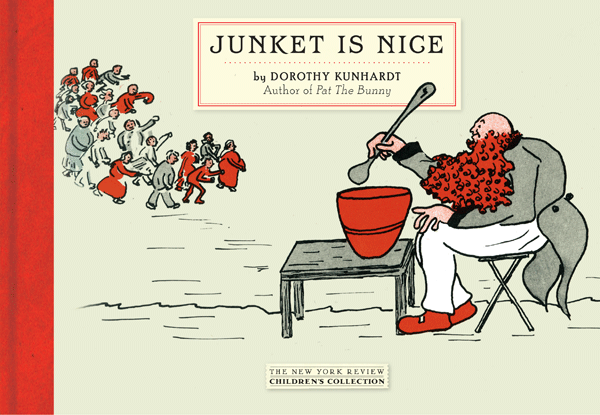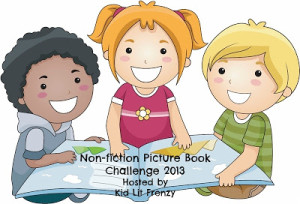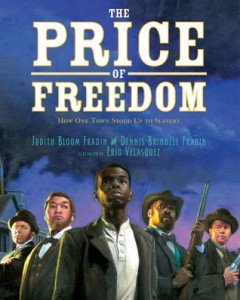Junket is Nice
Author: Dorothy Kunhardt
Published: June 25th, 2013 by NYR Children’s Collection
(First published: 1933)
Summary: An old man with a red beard and red slippers eats junket out of a big, red bowl. All of the people arrive and want to know what he thinks about while he eats his junket. The old man tells them the three things he is NOT thinking about, and the people try to guess what he is thinking. Only the little boy, who arrived last, truly knows what the old man is thinking while he is eating his junket.
Ricki’s Review: Kids will love the crowd’s nonsensical guesses of what the old man is thinking about while he eats his junket–from “a kangaroo jumping over a glass of orange juice so as not to spill it” to “a bear climbing a ladder because his toenails are too long for walking on the ground”–I can imagine a whole class giggling as the people make their guesses.
Dorothy Kunhardt has a very creative imagination that kids are sure to enjoy. The drawings are very humorous, and I couldn’t help but chuckle as I read this picture book–the idea of a “daddy-long-legs holding up his foot for the sun to warm it” is just very silly! Junket is Nice would allow for a lot of great, creative thinking in the classroom. Readers of Pat the Bunny are sure to enjoy this classic.
Kellee’s Review: This book is so full of imagination. The clever, funny animals that the crowd comes up with while trying to guess what the old man is thinking will definitely, like Ricki says, make a whole class giggle. It also will be the most discussed part of the book, I’m sure. You can tell that Dorothy Kunhardt was full of imagination and wanted to make this book as fun as possible. Her son remembers her being curious and appreciating the way young people viewed the book, and you can tell by Junket is Nice that she embraced this curiosity and put as much of it into her books as possible.
Teacher’s Tools for Navigation: Teachers could use this book and have students create their own riddles like Kunhardt’s–“What is the old man thinking while he eats his junket?” They could even create their own picture books for their riddles. Alternatively, a teacher might read all the way up to the section of the book that gives the answer to the riddle. Then, each student in the classroom might draw their own creative guess about what the old man is thinking. This would allow students to make predictions, based on the other guesses within the book.
Discussion Questions: What might the old man be thinking about when he eats his junket?; Why might the little boy be the only one who knows what the old man is thinking about?; Was the ending satisfying, or did you wish the old man was thinking about something else?
We Flagged: “‘People why don’t you try and guess what I am thinking about all the time I am eating my junket and if you guess right I will give you something nice'” (p. 16).
Read This If You Loved: Pat the Bunny by Dorothy Kunhardt, The Napping House by Audrey Wood, That is Not a Good Idea by Mo Willems, other picture book classics like Make Way for Ducklings by Robert McCloskey and The Little House by Virginia Lee Burton
Recommended For:
Don’t forget to enter the giveaway below so you can win your own copy of Junket is Nice!
**Thank you to Media Masters Publicity for providing copies for us to review**






